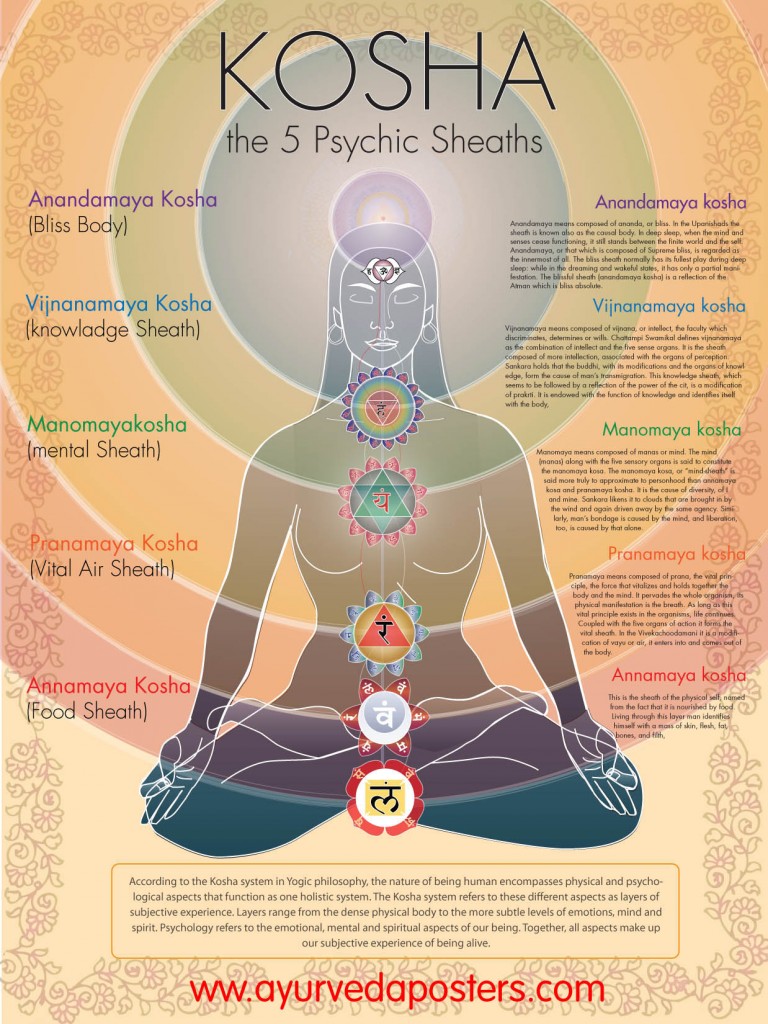The three bodies and five sheaths
Within yoga philosophy, it is said that our bodies are actually made up of three bodies; the physical, astral and causal. Within these three bodies are five sheaths or 'koshas'; annamaya kosha, pranamaya kosha, manomaya kosha, vijnanamaya kosha and anandamaya kosha.
Lets start with the three bodies.
Physical body
This is the most obvious one, it is the skin and bones we are made up of. Our physical bodies are made up of five elements; earth (prithivi), water (apas), fire (agni), air (vayu) and ether (akasha). We can balance or heighten these elements through our asana practice. We can create agni (fire) in the belly through leg raises and headstands. We can balance the vayu (air) using deep breathing in our postures. We can create a stronger sense of prithivi (earth) using grounding postures like warriors or tree pose.
Astral body
Our astral bodies are our way of feeling pleasure or pain. It relates to our senses. There are five organs of action (known as karma indriyas), five organs of knowledge (known as jnana indriyas), five pranas and four elements of antahkarana (the inner instrument). This antahkarana is made up of the mind (manas), intellect (buddhi), subconscious (chitta) and ego (ahamkara). So in total there are 19 elements that make up our astral body - the body used for feeling and sensing.
Causal body
The casual body, aka the seed body, is our blueprint of the gross and subtle bodies. It is a body that is much harder to sense and one we quite often forget to find the connection with. It links to our bigger Self. It contains all our previous experiences, memories, habits and information on all the lives we have already lived. The astral and the causal bodies remain together at the time of death, both exiting the physical body.
The five sheaths or koshas
Annamaya kosha - the food sheath
Our physical bodies are made up of the material elements of the physical world. We are what we eat, so to speak. We are made up of food and will return to the earth, where our food came from, after our death. This sheath belongs to the physical body.
Pranamaya kosha - the vital sheath
This sheath belongs to the astral body. We are composed of five vital energies, all of which flow through the physical body via the astral plane; prana, apana, samana, udana and vyana (I will write another blog on the vital energies so please check back soon if you want to learn more). The pranamaya kosha also contains the five organs of action (the karma indriyas); mouth, hands, feet, anus and genitals. Within this kosha, we experience hot, cold, hunger and thirst etc.
Manomaya kosha - the mental sheath
This sheath again sits in the astral body. We experience thought through this sheath. We can experience thinking, doubting, anger, lust etc. The elements are; mind (manas), subconscious (chitta) and the jnana indriyas (the organs of knowledge; eyes, ears, nose, tongue and skin).
Vijnanamaya kosha - the intellectual sheath
This sheath relates to the astral body. It consists of the intellect (known as the buddhi) which analyses the information we receive. It also controls the ego (ahamkara), our self-assertive principle. It works alongside the five organs of knowledge, listed above. Discrimination and decision making are its manifestations.
Anandamaya kosha - the bliss sheath
This is the only kosha that sits in the causal body. It's the part of us that experiences bliss, joy and peace. This is the part of us that we tend to lose connection with as it's the most difficult body to feel. Our aim in yoga is to reach connection with the anandamaya kosha - when we reach that inner place where everything is silent and calm, we have found our connection with anandamaya.

